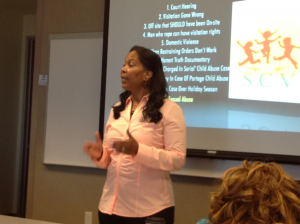If, after conducting an intake, the Provider accepts a referral for visitation in a domestic violence case, it is important to identify behaviors that may subsequently impact visitation. It is critical to keep in mind that the goal of providing supervised visitation services, including Provider exchanges, is to provide a safe, neutral setting for parent-child access. If this cannot be accomplished, the visitation program must not accept the referral.
The following are behaviors sometimes used by batters that may affect a program’s ability to provide safe visitation:
- Threats of violence toward the victim. This may include verbal abuse as well as attempted or actual physical assault.
- Threats of violence toward children. This may include verbal abuse, threats, attempted or actual physical abuse, kidnapping.
- Using visitation to send messages to the victim through the children.
- Stalking the victim and children upon arriving or departing from visitation program. This can be done in person or through a third party family member or friend.
- Intimidating children to reveal their current living arrangement, their custodial parent’s activities, their phone numbers.
- Testing or violating staff or volunteers.
- Intimidating visitation staff or volunteers.
- Pitting one staff member against another to encourage divisiveness.
- Requesting “special” privileges, such as unsupervised time with children.
- Denial or minimization of abusive behavior (“It’s all a misunderstanding.”).
- Blaming other parent for necessity of having to use visitation services.
- Attempting to bring weapons (guns, knives, etc.) into program.
- Threats or attempts to commit suicide.
Reducing Risk and Enhancing Safety for Visitation Providers
The point at which visitation services are ordered is often the period of greatest risk to the victim and children. Research indicates that victims leaving violent relationships face the greatest risk of death or serious injury in the period following separation. To enhance victims’ and children’s safety, programs should structure services in the following ways:
- Providing well-designed security arrangements on site. This may include a formal policy for using on- site law enforcement officers, panic buttons to alert local law enforcement to problems, and other tools that staff are thoroughly trained in using, such as weapon detectors;
- Having a safety plan in place for each family. This plan includes initial and ongoing identification of the risks to each member of the family;
- Ensuring that perpetrators and victims do not come in contact with each other during visitation or Providers exchanges;
- Arranging for separate arrival and departure times for victims and perpetrators;
- Intervening in the visit if perpetrator denies, minimizes, or blames his or her partner for violence;
- Reporting to the referring court any incident which affects the safety of program participants or staff; and
- Requiring victims to bring a copy of their injunctions for protection for program records.

Follow Us!